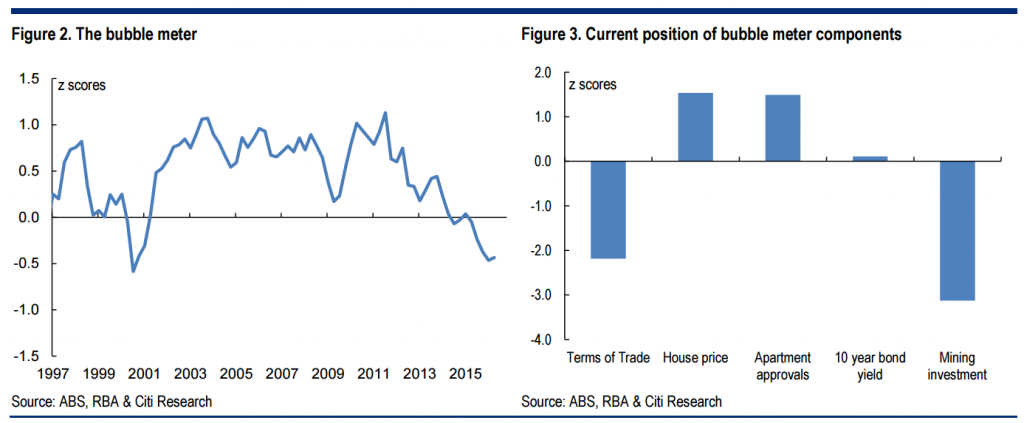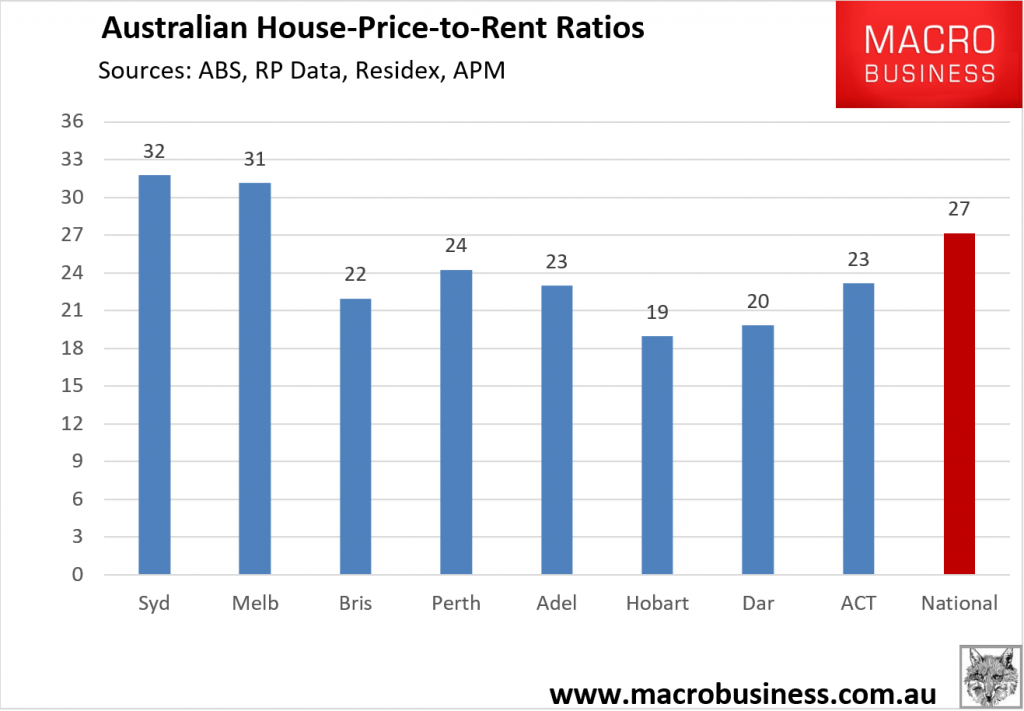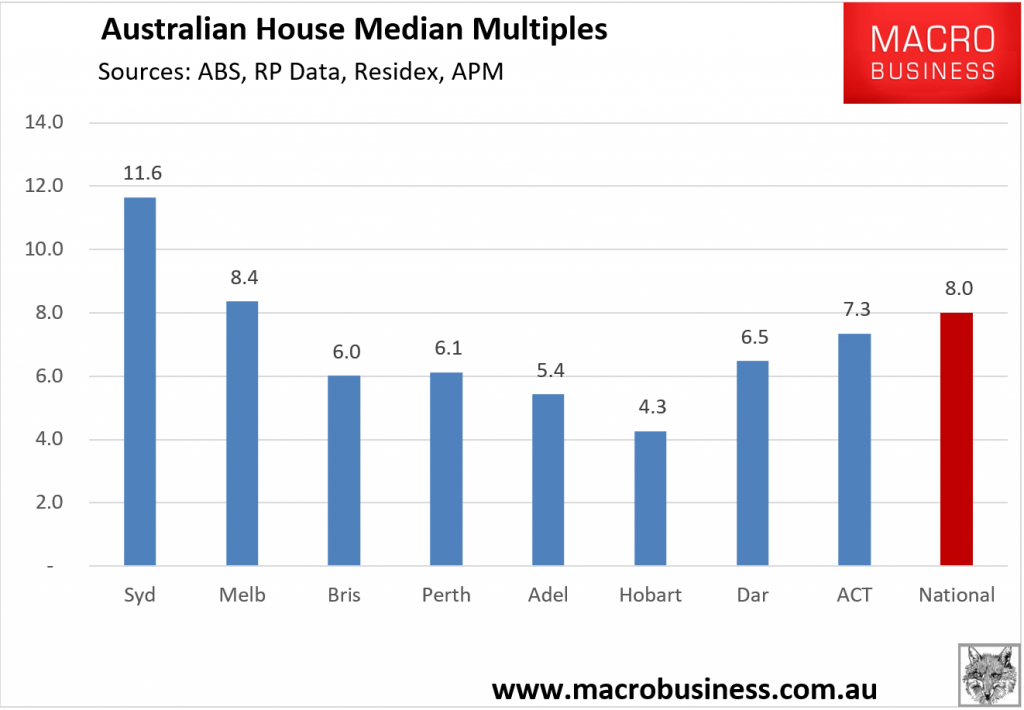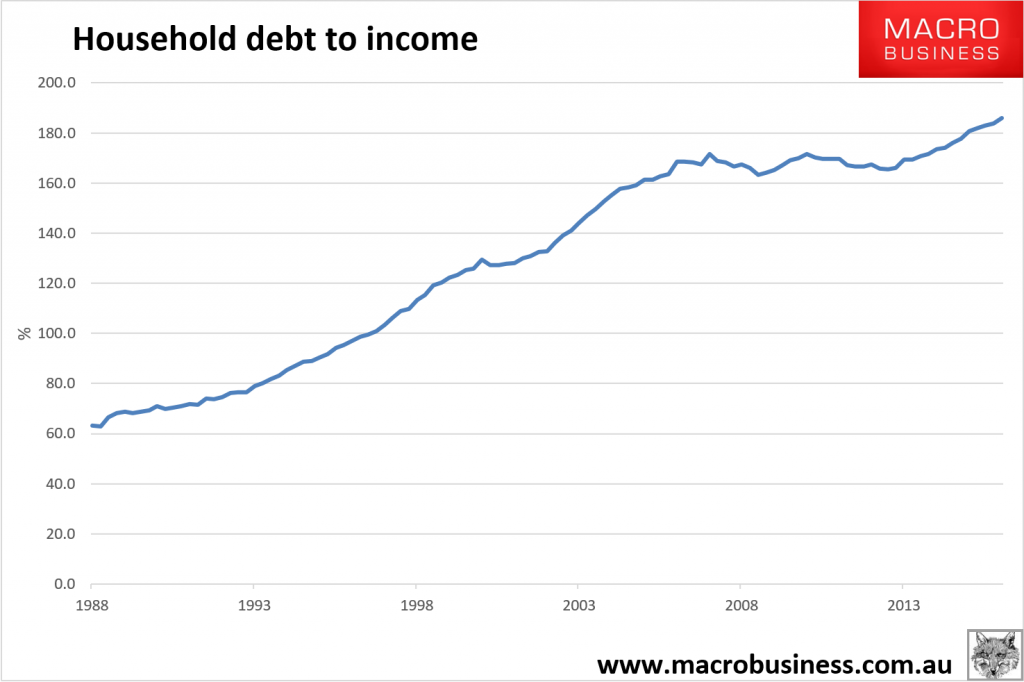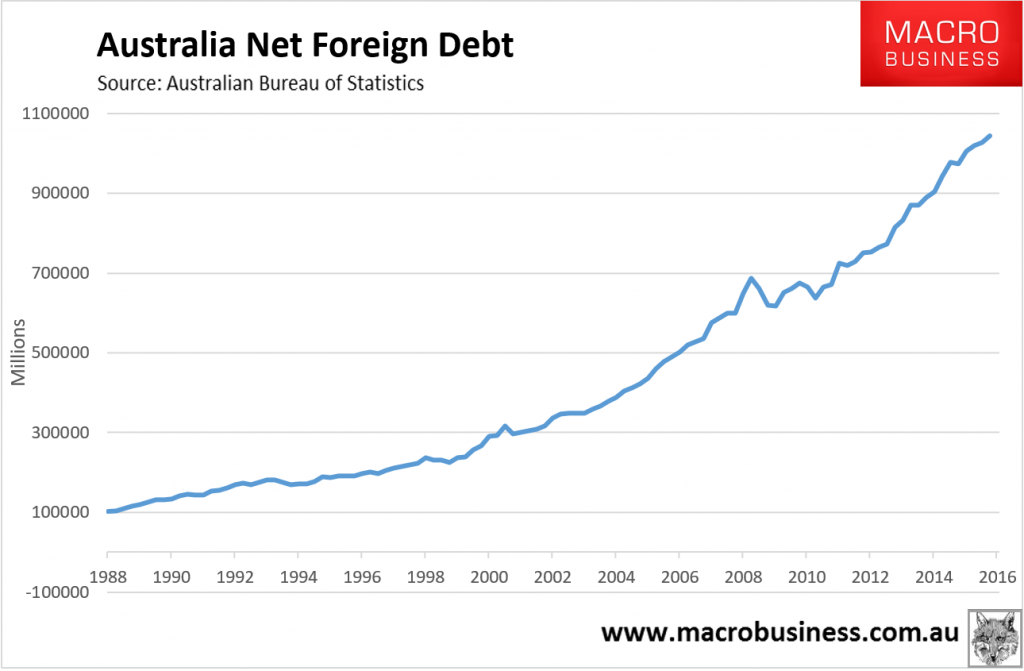Australian property bubble on a scale like no other Yesterday Citi produced a new index which pinned the Australian property bubble at 16 year highs: Bubble trouble. Whether we label them bubbles, the Australian economy has experienced a series of developments that potentially could have the economy lurching from boom to bust and back. In recent years these have included: the record run up in commodity prices and subsequent correction; the associated boom in mining investment and current reversal; record low bond yields; the boom in housing construction, specifically apartments, that was spurred by the low interest rates. Housing indicators in the bubble meter are at record highs but interest rates remain at record lows. Typically monetary policy is well into tightening mode at this stage in the housing cycle. A destabilizing housing burst (both in activity and prices) is a clear risk, particularly the longer the upswing runs. Australia Bubble Meter Australia Bubble Meter - Click to enlarge The size of the Australian property bubble is old news.
Topics:
David Llewellyn-Smith considers the following as important: Bond yield, Debt and the Fallacies of Paper Money, Featured, newslettersent, Real estate
This could be interesting, too:
Nachrichten Ticker - www.finanzen.ch writes Die Performance der Kryptowährungen in KW 9: Das hat sich bei Bitcoin, Ether & Co. getan
Nachrichten Ticker - www.finanzen.ch writes Wer verbirgt sich hinter der Ethereum-Technologie?
Marc Chandler writes March 2025 Monthly
Mark Thornton writes Is Amazon a Union-Busting Leviathan?
Australian property bubble on a scale like no other
Yesterday Citi produced a new index which pinned the Australian property bubble at 16 year highs:
Bubble trouble. Whether we label them bubbles, the Australian economy has experienced a series of developments that potentially could have the economy lurching from boom to bust and back. In recent years these have included:
- the record run up in commodity prices and subsequent correction;
- the associated boom in mining investment and current reversal;
- record low bond yields;
- the boom in housing construction, specifically apartments, that was spurred by the low interest rates.
Housing indicators in the bubble meter are at record highs but interest rates remain at record lows. Typically monetary policy is well into tightening mode at this stage in the housing cycle. A destabilizing housing burst (both in activity and prices) is a clear risk, particularly the longer the upswing runs.
Australia Bubble Meter
What is less well understood is how such a large and sustained bubble has distorted the Australian political economy. The bubble has been running for twenty years (which some argue proves it is no such thing) and every time it has been threatened it was saved by luck or a bailout which sold off a little more of Australia’s liberal democracy.
In 2003, the bubble first threatened to burst as the Reserve Bank raised interest rates. But the bubble was rescued by the combined forces of demand side fiscal stimulus for first home buyers in the form of large cash grants, and the arrival the Chinese commodity boom that flooded the economy with people and income. The government of the day learned its lesson and economic reform has been dead ever since!
In 2008, the bubble was jeopardised again when the pipeline of offshore debt froze solid and major Australian banks were rendered insolvent given they could not roll over their enormous foreign debts. The government of the day rode to their rescue with guarantees to all offshore funding, directly bought mortgage backed securities (which it still holds), unleashed the largest proportional fiscal stimulus in the world, doubled the first home buyer grants, opened the spigots on foreign investor buying, and other measures. Almost all of it violated existing financial sector architecture and governance and virtually none of it has been wound back. No housing market in the world enjoyed such wholesale and limitless support.
In 2011, the bubble again faltered when the China commodity boom returned and raised interest rates. But, when threatened, the bubble was bailed out, this time by a central bank that desperately cut interest rates to all-time lows because it had over-estimated the durability of the commodities boom, and an influx of Chinese capital that was allowed to price-out local buyers with barely a word of protest from regulatory authorities.
While those three saves of the bubble have been widely admired as solid Keynesian policy-making, and have allowed Australia to claim a “miracle” economic expansion of 25 years, they have also transformed its economy and political economy.
The Australian economy is now structurally uncompetitive as capital inflows persistently keep its currency too high, usually chasing land prices that ensure input costs are amazingly inflated as well. Unsurprisingly, Australian manufacturing’s share of outlook has collapsed to 5.8% of GDP (even before the exit of car manufacturing scheduled for the next 12 months) half that of the supposedly “hollowed out” US and UK economies, and on a par with the financial haven of Luxembourg. Wider tradables sectors have been hit hard as well and Australian exports are now a lousy 20% of GDP despite the largest mining boom in history.
The other major economic casualty has been multi-factor productivity. It has been virtually zero for fifteen years as capital was consistently and massively mis-allocated into unproductive assets. To grow at all today, the nation now runs chronic twin deficits with the current account at -4% and Budget deficit of -3% of GDP.
But the damage is in some ways even worse in the political economy. How have Australian authorities responded to this growing crisis? By egging it on.
Not only are they running unsustainable deficits into looming sovereign downgrades, they have sustained historically very high rates of immigration to attempt to back-fill and support property prices. These levels have been so aggressive in the major eastern cities, which are now projecting a near doubling of their populations within 40 years (from four-plus to eight million), that elections are now routinely won and lost on issues of choked infrastructure, and a vehemently anti-immigration movement is afoot in the polity. Younger generations are also boiling over with anger at being locked out of housing markets. A full half of first home buyers rely upon parents for equity and their numbers have collapsed to just 12% of total sales.
Five prime ministers in six years have come and gone as standards of living fall in part owing to massive immigration inappropriate to economic circumstances and other property-friendly policy. The most recent national election boiled down to a virtual referendum on real estate taxation subsidies. The victor, the conservative Coalition party, betrayed every market principle its possesses by mounting an extreme fear campaign against the Labor party’s proposal to remove negative gearing. This tax policy allows more than one million Australians to engage in a negative carry into property in the hope of capital gains. In a nation of just 24 million, 1.3 million Australians lose an average of $9k per annum on this strategy thanks to the tax break.
The campaign against tax reform was led by former head of Goldman Sachs Australia, Prime Minister Malcolm Turnbull, who is a large Australian property-holder, and Treasurer Scott Morrison, who is the former head of research at the Property Council of Australia, the nation’s leading realty lobby. Australia’s 225 politicians hold a combined property portfolio worth over $300m.
The property corruption has even undermined the nation’s strategic outlook. The large wave of Chinese immigrants and investors have been accompanied by a hard-edged soft power drive from Beijing that is sorely undermining Australia’s commitment to its traditional US alliance partner. Chinese bribery scandals have erupted in the parliament, usually from property-based sources, and have clearly perverted policy-making. So much so, that Australia’s defence and espionage agencies are in a rising panic that Australia is literally auctioning its strategic outlook to Chinese property speculators.
How could all of this happen without the media holding it to account? As the economy gets ever more reliant upon its great foreign-funded housing ponzi scheme, and the political economy wraps ever more tightly around it, Australian media has been engulfed as well. Aussie media is a duopoly divided between a conservative Murdoch press and liberal Fairfax press. But both are largely loss-making old media empires whose only major growth profit centres are the nation’s two largest real estate portals, realestate.com.au and Domain. Thus neither reports real estate with any objective other than the further inflation of prices. Indeed newspaper (print and online) operations are nothing more than loss-leaders for over-excited real estate eyeballs. In the event that the Australian bubble were to pop then Australians will certainly be the last to know and the propaganda is so thick that they may never find out until they actually try to sell!
Before the year 2000, the Australian economy was a vibrant mix of world-leading productivity growth, liberalised tradable sectors balanced between commodities, services and manufacturing, solid household wealth, a reasonable external position, a clean public balance sheet and reliable institutions.
Today, it is a wildly imbalanced propertocracy with enormous offshore debts, a polity soaked by a Goebbels-like property propaganda machine, and a government run by realty carpet-baggers willing to sell their children to Chinese communists so long long as they pick up a three bedroom apartment along with little Johnny.
In a world replete with bubbles, rarely has one been quite so complete!
Charts by: ABS, RBA & Citi Research, MacroBusiness
This post originally appeared on MacroBusiness.

